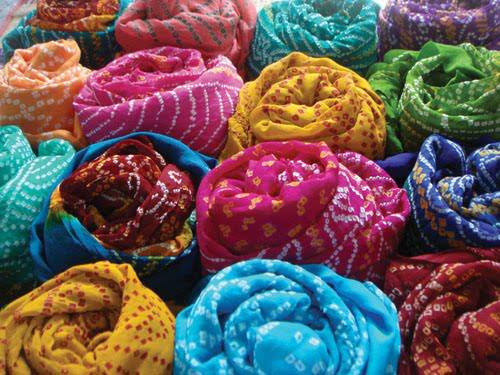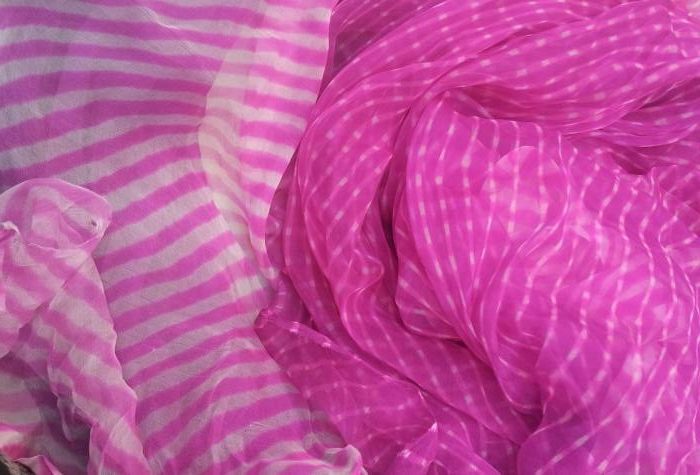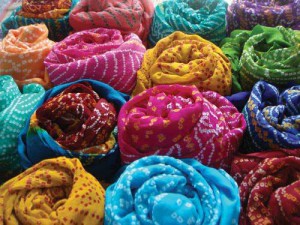
Lehariya or Leheria
Lehariya or Leheria is a simple style of tie and dye from the state of Rajasthan, India. Traditionally seen in bright colors it has a very distinctive striped pattern. Literally translating to the term ‘wave-like’, lehariya symbolizes the unique and rich costume heritage of Rajasthan.
Leheriya was conceived in the 19th century and has been a coveted choice in the apparel and embellishments industry ever since. Within the domain of tie and dye, leheriya is one of the most widely recognized designs.
The Making
It is the dyer’s extraordinary skill that paints magic onto a simple cotton or silk cloth. The cloth manufacturer makes use of a special method known as resist-dyeing. The cloth that is used in the process is of a lighter color, generally in cotton, silk, chiffon or georgette. The cloth is tied and folded in such a manner that when opened post-dyeing, there is a striped pattern created on the cloth with color on every alternate stripe. Traditionally, craftsmen would tie and dip it in 5 different colors to get the desired pattern in multiple hues. Natural dyes were used and finished off with indigo for shades of blue, and Alizarin for the hues of red in the final stages.
(Also Read: Marwar Festival)
Depending on the skill and imagination of a worker, every fabric gets a new look, with vivid colors, fresh patterns and vibrant designs.
Sources of Inspiration
As far as regional influences and inspirations are concerned, the leheria style has been inspired by regions in and around Gujarat, such as Udaipur in Rajasthan. The motifs and designs portray a sense of joy and colorfulness, retaining the simplicity of the culture of Gujarat.
Innovations and Variety
It is interesting to note that the leheria has been able to retain its original essence ever since its inception. In its earliest form, leheria was a style mainly used in head turbans. As time progressed, leheriya was introduced in lehenga cholis, salwar kameez and sarees. Nowadays, leheria is a part of both attire and accessories. One can find the style on ethnic and casual clothing, bags and shoes, as well as on scarves and cravats.
(Also Read: Rajasthani Chaniya Choli)
Global Wearability
The bright colors and lightness of the fabric makes leheriya a great fit for the global stage. It is a popular fabric in the export market too and has been showcased in fashion shows worldwide.
Since leheria prints are usually created on soft and light fabrics, it is preferred in regions with a warmer climate.
Wearing Leheria
The light and vibrant hues of leheria is apt for spring and summer. The colorful fabric in the form of a dupatta can be used to adorn solid colored salwar kameez. Alternatively, it can also be teamed up with Indo-Western attires to add a splash of vibrancy.
Maintenance
A lehariya adorned fabric is not very difficult to maintain. It can be maintained just like any other georgette, chiffon or cotton fabric. One common problem that most purchasers face is color bleeding. However, the easiest and quickest fix for this problem is to soak the garment overnight, in a bucket of water that contains a teaspoon of salt. This process fastens the colors on the cloth.
Interesting Facts about Leheria
- For a number of years, leheria was a style that exclusively belonged to the Marwari community in Rajasthan.
- Those who belonged to the royal class wore blue leheria attire.
- The most common base color on which leheria is practiced is white.
- Leheria is much easier to maintain than a style like block printing
- The price of an apparel featuring leheria depends on the number of times the cloth has been dyed and the textile used.
Reference
Categories: Motifs & Embroideries


